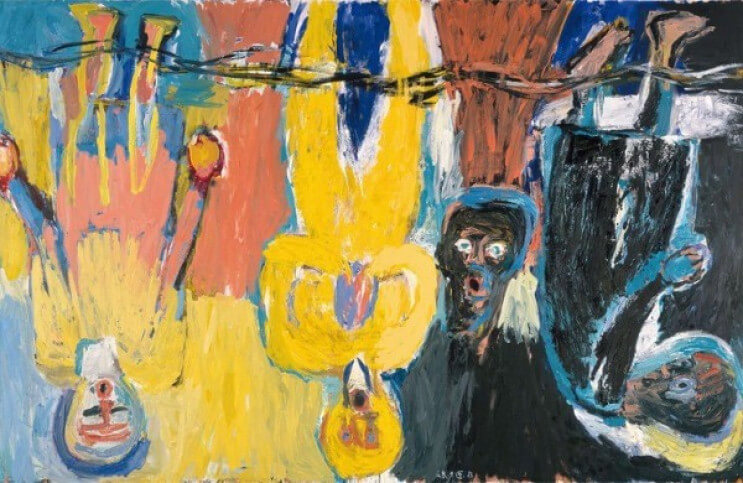
Finding Abstraction within the Neo-Expressionism
The study of Neo-Expressionism can lead one down a rabbit hole. Innumerable elucidations of this late-20th Century art movement exist. Each seems to differ in its perspective, in often-contradictory ways, as if no consensus exists on what Neo-Expressionism truly is, or was. Some say it began in Germany; others say Italy; others say the United States. Some say it began in the 1960s; others say the 1970s. Some call it the natural extension of German Expressionism and Abstract Expressionism. Others call it a reaction against Minimalism. Still others claim it was not an authentic art movement at all, but an invention of the art market. One point almost everyone agrees on is that Neo-Expressionism was one of the last quantifiable global art movements to occur before the onset of what we commonly refer to as Post-Modernism, when artistic pluralism took hold and all knowledge and meaning came to be seen as subjective. All of that aside, our fascination with Neo-Expressionism lies purely in the art: in its associative abstract qualities, and in the way it has outlasted the questions about its worth.
The Truth About Art Movements
As for the notion that Neo-Expressionism was an invention of the art market, we want to clear up that it was exactly as real as any other movement in art. One of the funny controversies about art history is whether any so-called movements ever really existed. The movement myth proposes that during certain time periods important artists were all making one type of art, and any artist not making that type of art at that time was considered irrelevant. And while it may be true that during certain time periods only certain styles of art were popular with academia and the market, anyone looking beyond those niches into the real world quickly realizes that many different types of art have been continuously made at all times by artists everywhere.
Nonetheless, we divide art history up into movements, even though we can prove that Wassily Kandinsky and Kazimir Malevich did not invent abstraction, Jackson Pollock did not invent splatter painting, Paul Bilhaud did not paint the first monochromatic two-dimensional surface and Julian Schnabel was not the first artist to make a broken plate mosaic. Artists have engaged in all of those practices for thousands of years. But at some point they became newly relevant. Some critic, curator, teacher, art seller, or art collector recognized what one of those artists was doing as peculiarly important to their time and described and named their position; not because it was completely new, but because at that moment something about it seemed like it could help people in their search for identity and meaning.
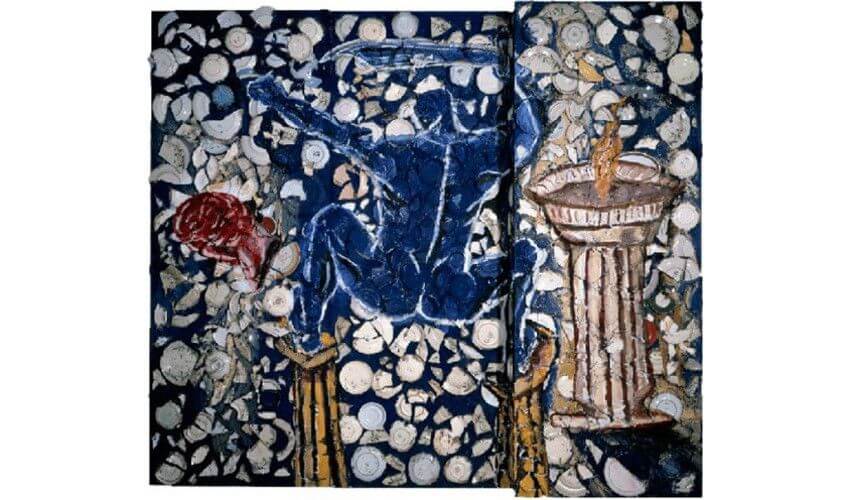 Julian Schnabel - Blue Nude with Sword, 1979, Oil, plates, bondo on wood, 96 x 108 in, © 2018 Julian Schnabel
Julian Schnabel - Blue Nude with Sword, 1979, Oil, plates, bondo on wood, 96 x 108 in, © 2018 Julian Schnabel
Neo-Expressionism Defined
The exact qualities that made Neo-Expressionist work stand out as newly relevant to its time are difficult to describe. The tendencies associated with the movement emerged simultaneously in many different countries, and each artists involved had a distinctly personal style. Some were more abstract, and others were hyper-realistic. In the United States, artists as diverse as Jean-Michel Basquiat, Philip Guston and Julian Schnabel represented the movement. In Italy, where it was known by the term Transavanguardia, it included artists like Enzo Cucchi, Mimmo Paladino and Francesco Clemente. In France, where the movement was called Figuration Libre, it included Remi Blanchard, Hervé Di Rosa and François Boisrond.
But the most influential Neo-Expressionist was from Germany. The painter Georg Baselitz is considered the father of the movement, and from his work we can get some idea of what have come to be considered the hallmarks of the Neo-Expressionist style. Those hallmarks include a return to direct expression of the realistic world, a rejection of traditional compositional theories, a combination of Expressionist figuration and abstract gestural techniques, a primitive aesthetic, a focus on expressing yearning and anxiety, and a renewed acceptance of the idea of storytelling in art.
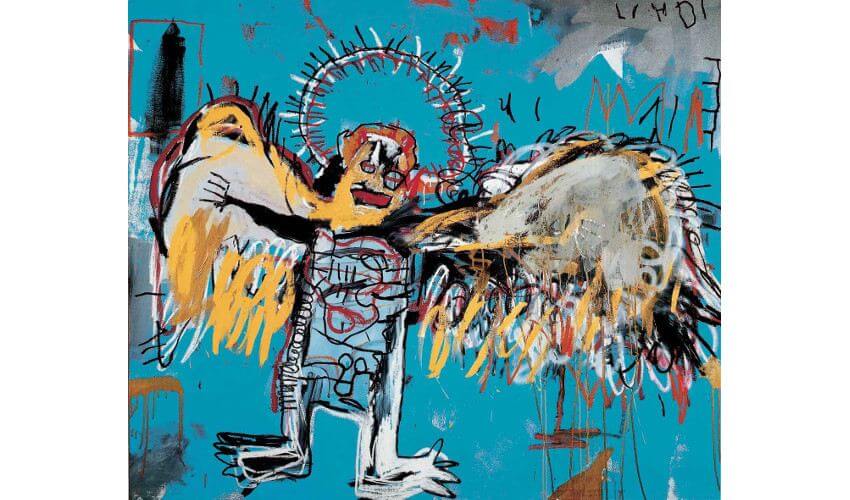 Jean-Michel Basquiat - Fallen Angel, 1981, Acrylic and mixed media on canvas, © 2018 The Estate of Jean-Michel Basquiat
Jean-Michel Basquiat - Fallen Angel, 1981, Acrylic and mixed media on canvas, © 2018 The Estate of Jean-Michel Basquiat
Neo-Expressionist Roots
The name Neo-Expressionism relates to the figuration and use of paint embraced by turn of the Century German Expressionist artists like Edvard Munch and Vincent van Gogh. Those artists developed a style of painting that was characterized by distorted imagery, primitive painting techniques and unrealistic colors. Rather than trying to make paintings that mimicked reality, the German Expressionists attempted to express something deeper about human existence: something internal, emotional, psychological, universal, and abstract.
Rather than showing what a person on a bridge looked like at the turn of the 20th Century, The Scream by Edvard Munch expresses the terror, anxiety, and turmoil of the dawn of the Industrial Age. Neo-Expressionist artists like Baselitz, Schnabel and Guston attempted a similar kind of approach but made it relevant for a much different time. They expressed the anxieties and terror of an age of globalism, technology, space travel, constant war, urbanization, endless social conflict, population explosion, and a general sense of individual meaningless within a cacophonic, over stimulated culture.
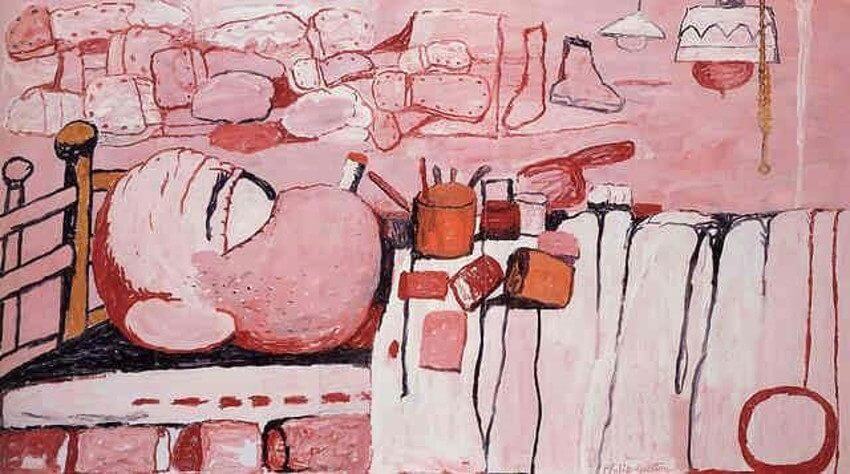 Philip Guston - Painter in Bed, 1973, Oil on canvas, 59 5/8" x 8' 8 1/4", 151.4 x 264.8 cm, MoMA Collection, Gift of Edward R. Broida, © 2018 The Estate of Philip Guston
Philip Guston - Painter in Bed, 1973, Oil on canvas, 59 5/8" x 8' 8 1/4", 151.4 x 264.8 cm, MoMA Collection, Gift of Edward R. Broida, © 2018 The Estate of Philip Guston
Abstraction Within Neo-Expressionism
Since Neo-Expressionism imagery is often figurative, it can easily be ignored as a source of abstraction. But one of the lasting legacies of Neo-Expressionism is that it expanded our understanding of what abstract art could be. The German Expressionist artist Ernst Ludwig Kirchner once described what it meant to be an Expressionist. He said, “Everyone who renders directly and honestly whatever drives him to create is one of us.” While some abstract art movements, such as Concrete Art, endeavored to be direct, most early abstract art strived toward a position that was open or ambiguous. Neo-Expressionism managed to be open as well as direct. It incorporated a vast range of subject matter and techniques and proved that figuration can also be read as abstract.
One of the most common abstract ideas communicated by Neo-Expressionist works is the notion of the collapse of modernity into antiquity. Elements of primitivism combine with modern symbolism indicating a simultaneous pull toward the past and the future. In the painting Cordoba by the Italian Transavanguardia artist Mimmo Paladino, we see two figures wrestling in a claustrophobic, uncanny space filled with references to ancient art, Expressionist art, and abstraction. The painting includes abstract geometric forms, color fields, monochromatic references, conveying a sense of being trapped in time surrounded by past myths, with no option but struggle.
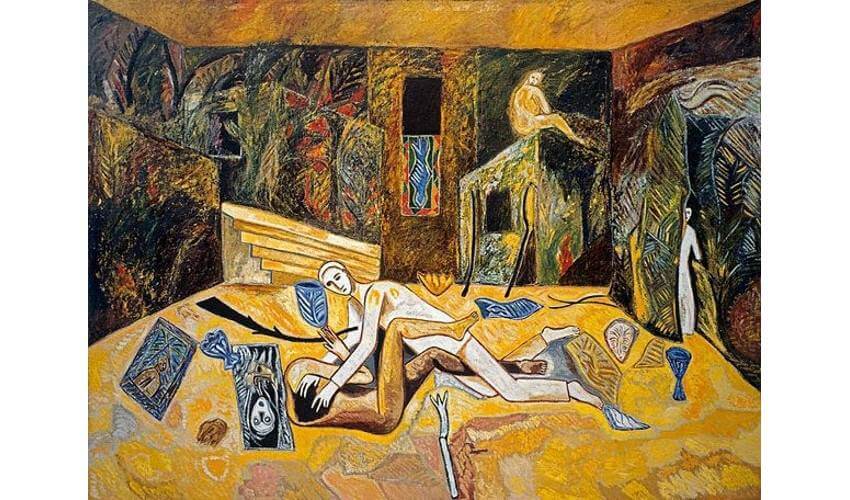 Mimmo Paladino - Cordoba, 1984, oil on canvas, 300.0 x 400.0 cm, Art Gallery NSW Collection, © Mimmo Paladino
Mimmo Paladino - Cordoba, 1984, oil on canvas, 300.0 x 400.0 cm, Art Gallery NSW Collection, © Mimmo Paladino
Abstraction by Association
One of the most effective ways Neo-Expressionist painters utilized abstraction was through the use of association. Essentially, association is when we allow our minds to follow one thought to another thought in a non-linear way, resulting in the rise of ideas that are personal and unpredictable. In life random associations can occur at any moment, sparked by an endless array of sensory experiences.
Neo-Expressionist painters used Associative Abstraction to offer hints toward deeper interactions with their art. When looking at their imagery associations are sparked by colors, textures, shapes, images, and symbols, creating narrative or mythological references in the work. Associative abstraction removes the notion that in order to be considered abstract a work of art must be non-objective. It enlarges the notion of abstraction and demonstrates that even a largely realistic image can cause associations that can be perceived as abstract.
The End of the Stories
Looking back at the birth of Modernism some people would say the mindset of those early Modernists seems quaint. The whole idea that the world could be made new by artists sounds a bit utopian and naïve. But the Modernists believed in the narrative of history, and that it was possible to change the world in ways that had not been tried before. They also believed that newness and change necessarily makes for a better world. It was that overarching narrative that history was linear and logical and that it could be built upon in progressive ways that led to Modernism and to every art movement that became part of it.
Many people consider Neo-Expressionism to be the end of that story. It combined aspects of multiple preceding movements. It combined abstraction and figuration. It revisited the past rather than strictly trying to be new. And it presented a compelling argument that there are really few, if any, differences between the present and the past. It demonstrated that every division and advancement associated with Modernism may have been false. It taught us that all art is direct, all art is expressive, and that all art is essentially abstract. As such it finished the work of Modernism. It paved the way for the pluralism we see in the art world today, and for the idea that every art movement and every aesthetic position can potentially exists simultaneously and be equally relevant to every time.
Featured image: Georg Baselitz - The Brucke Chorus (detail), 1983, Oil on canvas, © Georg Baselitz
All images used for illustrative purposes only
By Phillip Barcio






